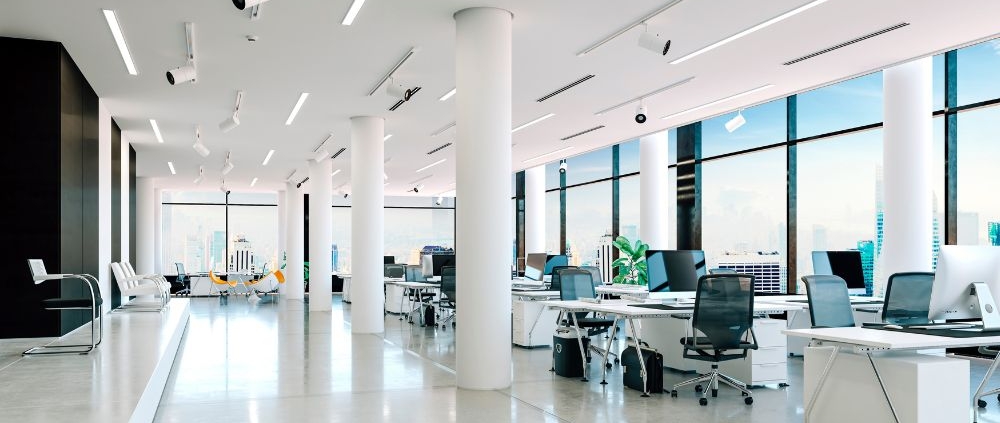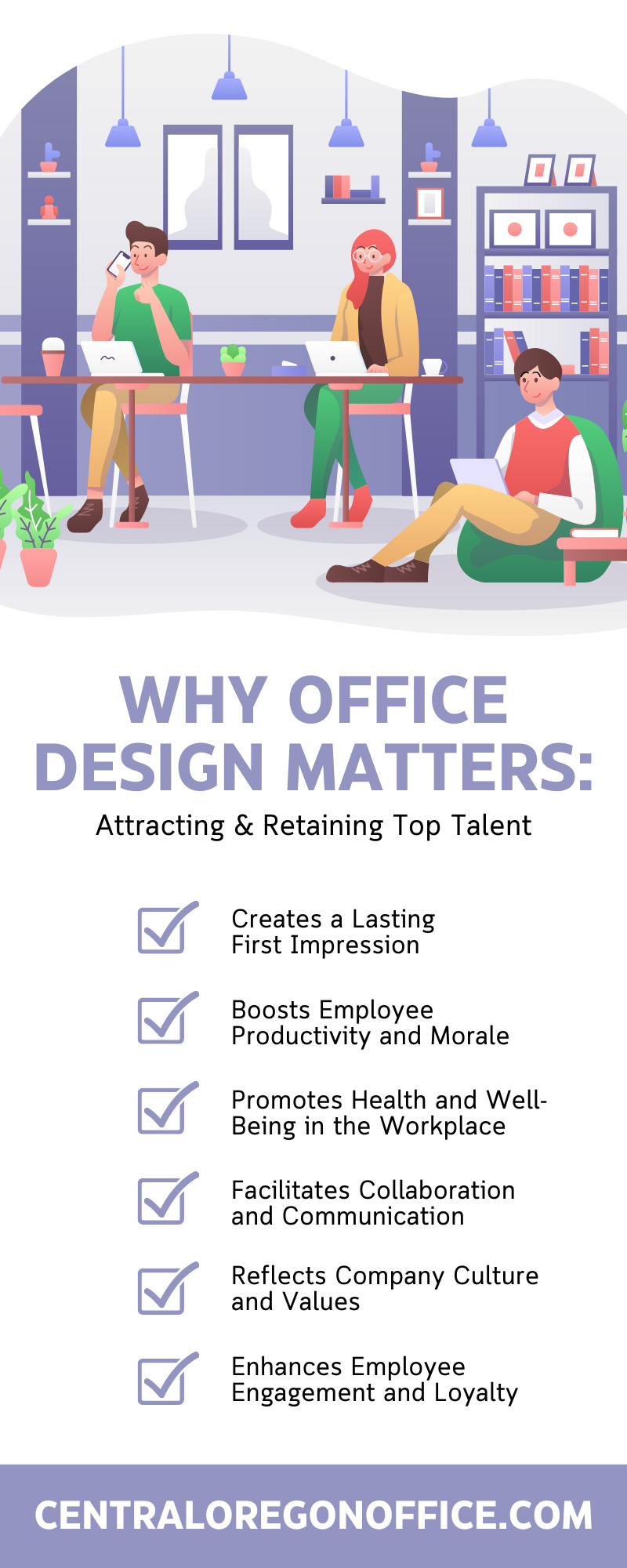Why Office Design Matters: Attracting & Retaining Top Talent
In the competitive landscape of talent acquisition, businesses are realizing that the work environment profoundly impacts whether top-tier professionals stick around or head for greener pastures. Office design isn’t just about aesthetics. It’s a strategic tool that can attract, empower, and retain employees. Join us as we discuss why office design matters in attracting and retaining top talent. Learn how to create an environment that maintains your competitive edge in the hunt for talent.
Creates a Lasting First Impression
The initial encounter with an office space sets the tone for any prospective or current employee’s view of the company. A well-thought-out, dynamic office design reflects the organization’s values, culture, and commitment to employee well-being. It serves as a tangible testament to the company’s innovation and dedication to fostering a supportive and stimulating work environment. This can be a decisive factor for top talent with offers from several companies.
An office that resonates with comfort, functionality, and aesthetic appeal can tilt the balance in your favor, making it a powerful tool for attracting new talent and ensuring the loyalty of existing workers. The message is clear: we value and invest in our people and create spaces that inspire and invigorate. This philosophy is at the core of building a motivated, high-achieving workforce.
Boosts Employee Productivity and Morale
The layout and design of an office can dramatically impact employee productivity and morale, which are key factors in attracting and retaining top talent. A thoughtfully designed office space that facilitates smooth workflows and reduces unnecessary interruptions can significantly enhance focus and efficiency. For instance, incorporating areas designed for collaboration alongside quiet zones for concentrated work allows employees to choose an environment that best suits their task at hand. This fosters a sense of autonomy and satisfaction.
Furthermore, visually appealing and ergonomically designed environments mitigate physical strain and elevate mood and mental clarity. This contributes to a more dynamic and engaged workforce. When employees feel their work environment aligns with their needs and optimizes their performance capability, it reinforces their commitment to the organization and its goals. By crafting office spaces that prioritize these aspects, companies signal their investment in employee success.
Promotes Health and Well-Being in the Workplace
Promoting health and well-being through office design is a strategic approach to creating a positive work environment. Considerations such as ergonomic office furniture, ample natural lighting, and noise control measures are vital components that contribute significantly to physical comfort and mental wellness.
By integrating these elements, companies underscore the importance of a balanced and healthy lifestyle, directly influencing an employee’s overall satisfaction and productivity. This thoughtful design aids in preventing work-related ailments and expresses the company’s care for its workforce.
Creating a workplace that genuinely promotes well-being is a powerful statement about a company’s priorities. This attentiveness to health is increasingly becoming a deciding factor for individuals seeking environments where they feel valued and supported, making it an essential strategy in maintaining a high-performing team.
Facilitates Collaboration and Communication
Strategic office design is pivotal in fostering collaboration and communication among employees, two cornerstones of innovative and successful businesses. Spaces structured to encourage interaction, such as open-plan offices, communal worktables, and informal meeting areas, facilitate the exchange of ideas and strengthen team bonds.
Companies can enhance creativity and accelerate problem-solving by reducing physical barriers and creating environments that promote social engagement. This type of office layout signals to current and prospective employees that the company values openness, teamwork, and a dynamic exchange of ideas. This can be particularly attractive to top talent looking for workplaces that champion collaboration and provide opportunities to contribute in meaningful ways.
The ability to easily connect and communicate with peers is a prerequisite for personal satisfaction and professional growth. By designing spaces that naturally encourage interaction, companies can attract and retain individuals who thrive in collaborative environments.
Reflects Company Culture and Values
Office design is a narrative tool mirroring an organization’s culture and values through its physical layout, choice of furnishings, and overall aesthetic. This alignment between space and ethos visually communicates the priorities and personality of the company to every person who walks through its doors. An office designed intentionally—whether it emphasizes sustainability, innovation, collaboration, or well-being—tells a compelling story about what the company stands for.
This can be a decisive factor for top talent seeking more than just a job but a place where they can align their personal values with their professional environment. A workspace thoughtfully crafted to reflect the company’s culture and values attracts the right kind of individuals—those who are likely to be engaged, committed, and loyal.
By embedding the company’s ideals into the very fabric of the office space, organizations reinforce these values among current employees and showcase them to potential future talents. This makes it a critical strategy to attract and retain the best in the field.
Enhances Employee Engagement and Loyalty
A thoughtfully designed workspace directly contributes to a sense of ownership and belonging among employees, fostering a strong connection to the organization. When individuals work in an environment that acknowledges their needs and promotes comfort and well-being, they are more likely to feel valued and, in turn, be more engaged with their work.
This enhanced engagement is a key factor in building loyalty, as employees are more likely to stay with a company that invests in creating an optimal work environment. Furthermore, a positive and supportive workplace culture becomes a beacon for attracting new talent.
Professionals seeking employment will often prioritize companies that demonstrate a commitment to employee satisfaction and well-being, viewing them as more appealing places to work. In sum, by embodying their company’s care for its workforce through strategic office design, businesses can increase employee loyalty and engagement and strengthen their position in the competitive talent market.
Carefully considering office design is paramount in shaping a company’s future. It’s clear why office design matters in attracting and retaining top talent; it embodies the company’s values, reflects its culture, and is a significant determinant of employee satisfaction and productivity.
Companies seeking to gain an edge in the competitive talent acquisition market would do well to invest in office space planning services in Bend, Oregon. These services can transform an ordinary workspace into an extraordinary environment that draws top-tier professionals and nurtures their growth and loyalty. The right office design goes beyond aesthetic appeal, serving as a strategic tool for fostering collaboration, promoting well-being, and securing the long-term commitment of valuable employees.




